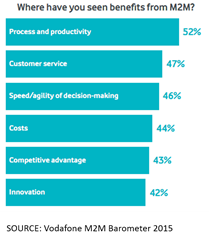あなたのビジネスにおけるモバイル アプリの爆発的な増加を無視していませんか?
「モバイル アプリ」と言うと、消費者向けのアプリを思い浮かべる人が多いでしょう。 ソーシャルアプリ。 アプリの共有。 ゲーム。 銀行業務。 地図。 アプリはエンゲージメントです。 アプリは収益です。 アプリは利益です。
しかし、それはまだ話の半分に過ぎません。 残りの半分は、ビジネスの内部、つまりビジネス運営の観点からのみ見えるものです。 この観点から見ると、アプリは生産性です。 アプリはお金を稼ぐためではなく、節約するためのものです。
こうしたビジネスオペレーションアプリは、企業の「アプリストア」を必要としているアプリであり、調査会社ガートナーは、2017 年までに企業の 4 分の 1 がアプリストアを導入すると予測しています。 Salesforce や Concur などの SaaS アプリケーション向けに提供されるモバイル アプリ インターフェースだけではありません。 これらは社内で開発されたアプリであり、ビジネス プロセスを自動化し、既存の手動プロセスの非効率性を排除するようにカスタマイズされています。
これらはかなりのペースで成長しているアプリです。 Canvas 2015 の調査によると、ほとんどの組織が 2014 年に少なくとも 1 ~ 5 個のモバイル ビジネス アプリを使用しており、驚くべきことに 20% の組織が 10 個以上使用していました。 しかし、それよりも興味深いのは、組織が手動プロセスをモバイル アプリに変換することで享受していると主張するコスト削減です。
これらはアンケートです。 在庫。 チェックリスト。 ガイド付きプロセス。 検査。 作業指示書。 ゲーム開発者が提供する、プロがデザインしたグラフィック満載のアプリに比べると、それほど魅力的ではありませんが、それでも重要です。 これらのアプリは、ビジネスを遂行するだけでなく、効率的に遂行するアプリです。
Canvas の調査によると、コスト削減を追跡している組織のうち、「17% がモバイル アプリに切り替えて年間 25,000 ~ 100,000 ドルを節約し、81% が 1,000 ~ 25,000 ドルのコスト削減を示した」ことがわかりました。 もちろん、注意すべき点は、この調査が「歴史的に紙のフォームと手作業のプロセスに大きく依存してきた企業規模と業界」に焦点を当てているということです。
しかし、だからといって、この調査の価値が低いと思わないでください。 業界は、建設・請負、フィールドサービス、小売・流通、ヘルスケア、製造、政府、運輸・物流など、非常に多岐にわたります。

これは確かに関連性があり、あらゆるタイプのビジネス、特にビジネス プロセスの効率性を向上させる必要があるビジネスにとってモバイル アプリケーションの重要性が高まっていることを示しています。
生産性は、電子メールやドキュメントの共有、プレゼンテーションだけではありません。 それは、従業員が特定のタスク、つまりビジネス プロセスをどれだけ効率的に実行するかに関するものです。 そのため、テクノロジーの使用によって強化できるビジネス プロセスは、紙からピクセルに移行することで強化され、消費者向けアプリと同様にモバイル アプリの爆発的な増加に貢献しています。
少し考えてみれば、モノのインターネットがモバイル ビジネス アプリと交差し、コスト削減にさらに爆発的な影響を与えることがわかるでしょう。また、それらのアプリケーションのアクセス、セキュリティ、配信を管理するために必要なインフラストラクチャとサービスにも影響が及ぶでしょう。 携帯電話は、IoT デバイスとのつながりにおける「つなぎ役」となることが非常に多く、携帯電話やタブレットのモビリティは、組織がビジネス管理のために社内で使用している、または今後使用するさまざまな「モノ」とやり取りするための完璧なパートナーとなります。
組織が M2M とモノのインターネットから実現しているメリットに関する、Vodafone の M2M バロメーター 2015 の調査結果を検討してください。 「プロセスと生産性」は、52%の組織でトップにランクされています。 これは偶然ではありません。M2M とモビリティの交差点はビジネス プロセスであり、それが生産性に直接つながるからです。
したがって、注意を払っていなかったとしても(あなたはそうではないと思いますが、注意を払っていたはずです)、ビジネスにおけるモバイル アプリの重要性を無視しないでください。 外部、つまり顧客向けのアプリと同様に、内部、つまりビジネス運営向けのアプリのセキュリティ、パフォーマンス、可用性にも注意を払うことが不可欠です。 ダウンタイムやアプリの速度低下が利益に影響を与えると考えるなら、すべてがモノやモバイル アプリに依存している場合、生産性とプロセスにどれほど影響を与えるかを考えてみてください。
